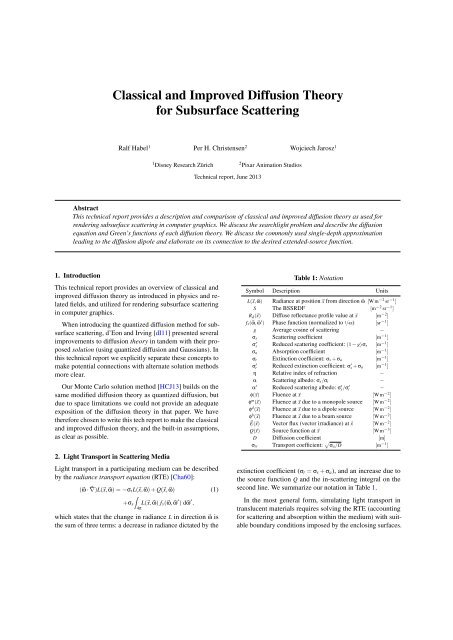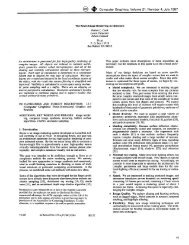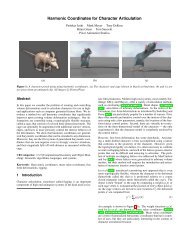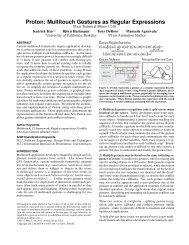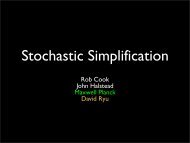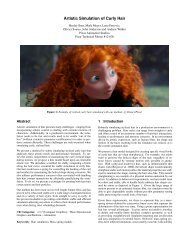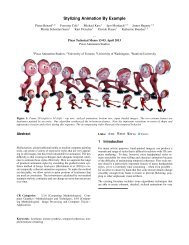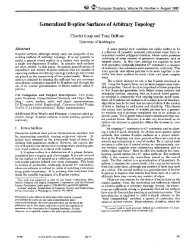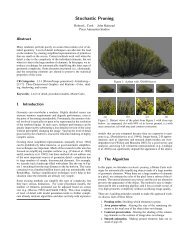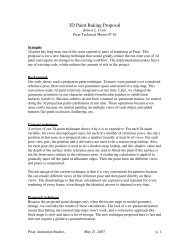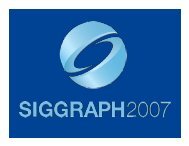Classical and Improved Diffusion Theory for Subsurface Scattering
Classical and Improved Diffusion Theory for Subsurface Scattering
Classical and Improved Diffusion Theory for Subsurface Scattering
Create successful ePaper yourself
Turn your PDF publications into a flip-book with our unique Google optimized e-Paper software.
<strong>Classical</strong> <strong>and</strong> <strong>Improved</strong> <strong>Diffusion</strong> <strong>Theory</strong><br />
<strong>for</strong> <strong>Subsurface</strong> <strong>Scattering</strong><br />
Ralf Habel 1 Per H. Christensen 2 Wojciech Jarosz 1<br />
1 Disney Research Zürich 2 Pixar Animation Studios<br />
Technical report, June 2013<br />
Abstract<br />
This technical report provides a description <strong>and</strong> comparison of classical <strong>and</strong> improved diffusion theory as used <strong>for</strong><br />
rendering subsurface scattering in computer graphics. We discuss the searchlight problem <strong>and</strong> describe the diffusion<br />
equation <strong>and</strong> Green’s functions of each diffusion theory. We discuss the commonly used single-depth approximation<br />
leading to the diffusion dipole <strong>and</strong> elaborate on its connection to the desired extended-source function.<br />
1. Introduction<br />
This technical report provides an overview of classical <strong>and</strong><br />
improved diffusion theory as introduced in physics <strong>and</strong> related<br />
fields, <strong>and</strong> utilized <strong>for</strong> rendering subsurface scattering<br />
in computer graphics.<br />
When introducing the quantized diffusion method <strong>for</strong> subsurface<br />
scattering, d’Eon <strong>and</strong> Irving [dI11] presented several<br />
improvements to diffusion theory in t<strong>and</strong>em with their proposed<br />
solution (using quantized diffusion <strong>and</strong> Gaussians). In<br />
this technical report we explicitly separate these concepts to<br />
make potential connections with alternate solution methods<br />
more clear.<br />
Our Monte Carlo solution method [HCJ13] builds on the<br />
same modified diffusion theory as quantized diffusion, but<br />
due to space limitations we could not provide an adequate<br />
exposition of the diffusion theory in that paper. We have<br />
there<strong>for</strong>e chosen to write this tech report to make the classical<br />
<strong>and</strong> improved diffusion theory, <strong>and</strong> the built-in assumptions,<br />
as clear as possible.<br />
2. Light Transport in <strong>Scattering</strong> Media<br />
Light transport in a participating medium can be described<br />
by the radiance transport equation (RTE) [Cha60]:<br />
(⃗ω · ⃗∇)L(⃗x,⃗ω) = −σ tL(⃗x,⃗ω) + Q(⃗x,⃗ω) (1)<br />
∫<br />
+σ s L(⃗x,⃗ω) f s(⃗ω,⃗ω ′ ) d⃗ω ′ ,<br />
4π<br />
which states that the change in radiance L in direction ⃗ω is<br />
the sum of three terms: a decrease in radiance dictated by the<br />
Table 1: Notation<br />
Symbol Description Units<br />
L(⃗x,⃗ω) Radiance at position ⃗x from direction ⃗ω [Wm −2 sr −1 ]<br />
S The BSSRDF [m −2 sr −1 ]<br />
R d (⃗x) Diffuse reflectance profile value at ⃗x [m −2 ]<br />
f s(⃗ω,⃗ω ′ ) Phase function (normalized to 1/4π) [sr −1 ]<br />
g Average cosine of scattering −<br />
σ s <strong>Scattering</strong> coefficient [m −1 ]<br />
σ ′ s Reduced scattering coefficient: (1 − g)σ s [m −1 ]<br />
σ a Absorption coefficient [m −1 ]<br />
σ t Extinction coefficient: σ s + σ a [m −1 ]<br />
σ t ′ Reduced extinction coefficient: σ ′ s + σa [m−1 ]<br />
η Relative index of refraction −<br />
α <strong>Scattering</strong> albedo: σ s/σ t −<br />
α ′ Reduced scattering albedo: σ ′ s/σ t ′ −<br />
φ(⃗x) Fluence at ⃗x [Wm −2 ]<br />
φ m (⃗x) Fluence at ⃗x due to a monopole source [Wm −2 ]<br />
φ d (⃗x) Fluence at ⃗x due to a dipole source [Wm −2 ]<br />
φ b (⃗x) Fluence at ⃗x due to a beam source [Wm −2 ]<br />
⃗E(⃗x) Vector flux (vector irradiance) at ⃗x [Wm −2 ]<br />
Q(⃗x) Source function at ⃗x [Wm −3 ]<br />
D <strong>Diffusion</strong> coefficient [m]<br />
σ tr Transport coefficient: √ σ a/D [m −1 ]<br />
extinction coefficient (σ t = σ s + σ a), <strong>and</strong> an increase due to<br />
the source function Q <strong>and</strong> the in-scattering integral on the<br />
second line. We summarize our notation in Table 1.<br />
In the most general <strong>for</strong>m, simulating light transport in<br />
translucent materials requires solving the RTE (accounting<br />
<strong>for</strong> scattering <strong>and</strong> absorption within the medium) with suitable<br />
boundary conditions imposed by the enclosing surfaces.
R. Habel, P. Christensen & W. Jarosz / <strong>Classical</strong> <strong>and</strong> <strong>Improved</strong> <strong>Diffusion</strong> <strong>Theory</strong> <strong>for</strong> <strong>Subsurface</strong> <strong>Scattering</strong><br />
Figure 1: The searchlight problem consisting of a semiinfinite<br />
planar homogeneous medium, a Fresnel boundary<br />
<strong>and</strong> a focused pencil beam of light entering the media. The<br />
pencil beam continues after the refraction as an exponentially<br />
decaying linear source. The light is absorbed <strong>and</strong> scattered<br />
<strong>and</strong> some of it exits the top boundary.<br />
2.1. The BSSRDF <strong>and</strong> the Searchlight Problem<br />
When rendering translucent materials, it is often convenient<br />
to re-<strong>for</strong>mulate this problem in analogy to the local surface<br />
reflection integral. This results in an integral equation which<br />
computes the outgoing radiance, L o, at position <strong>and</strong> direction<br />
(⃗x o,⃗ω o) as a convolution of the incident illumination, L i , <strong>and</strong><br />
the BSSRDF, S, over all incident positions <strong>and</strong> directions<br />
(⃗x i ,⃗ω i ):<br />
∫ ∫<br />
L o(⃗x o,⃗ω o)= S(⃗x i ,⃗ω i ;⃗x o,⃗ω o)L i (⃗x i ,⃗ω i )(⃗n ·⃗ω i ) d⃗ω i dA(⃗x i ). (2)<br />
A<br />
2π<br />
The most general method to solve this integral is brute-<strong>for</strong>ce<br />
Monte Carlo particle tracing. While this method is both general,<br />
intuitive, <strong>and</strong> simple to implement, un<strong>for</strong>tunately it gives<br />
noisy results <strong>and</strong> converges very slowly. Hence, researchers<br />
in fields such as medical physics, astrophysics, <strong>and</strong> recently<br />
computer graphics have developed alternative solution methods,<br />
<strong>and</strong> usually only use brute-<strong>for</strong>ce Monte Carlo particle<br />
tracing <strong>for</strong> validation.<br />
For efficiency, S is often decomposed into reducedradiance,<br />
single-scattering, <strong>and</strong> multi-scattering terms, S =<br />
S (0) + S (1) + S d , so that each can be h<strong>and</strong>led by specialized<br />
algorithms. Most previous techniques in graphics have approximated<br />
S (1) with the refractive single-scattering approximation<br />
proposed by Jensen et al. [JMLH01] <strong>and</strong> we propose<br />
an alternate diffuse single-scattering approximation [HCJ13].<br />
Accurate brute-<strong>for</strong>ce simulation of the multi-scattering term<br />
S d is as expensive as the general problem, so we rely on<br />
simplifications to the multi-scattering problem based on approximate<br />
solutions to the so-called “searchlight problem.”<br />
The searchlight problem, illustrated in Figure 1, considers<br />
a simplified setting where a focused pencil beam of unit<br />
flux is orthogonally incident at the origin on a semi-infinite<br />
planar homogeneous medium. Photons refract through a Fresnel<br />
boundary <strong>and</strong> travel in the downward direction until<br />
∞<br />
they are scattered or absorbed by the medium. The unabsorbed/unscattered<br />
photons <strong>for</strong>m an exponentially decaying<br />
linear source inside the medium. The scattered photons can<br />
be scattered again <strong>and</strong> ultimately get absorbed or escape the<br />
medium. The sum of all photons exiting the upper boundary<br />
at each point⃗x <strong>for</strong>ms a spatial diffuse reflectance profile R d (⃗x),<br />
which is radially symmetric (1D) <strong>for</strong> normally-incident light,<br />
R d (⃗x) = R d (‖⃗x‖). Even though the searchlight problem is simpler<br />
than the fully general setting, exact solutions only exist<br />
<strong>for</strong> special cases—we still rely on brute-<strong>for</strong>ce Monte Carlo<br />
particle tracing <strong>for</strong> validation, just as <strong>for</strong> the general problem.<br />
Most methods in graphics simplify S d as a product of a<br />
typically 1D, diffuse reflectance profile R d <strong>and</strong> a directional,<br />
energy-preserving Fresnel reshaping term [JMLH01, dI11]:<br />
S d (⃗x i ,⃗ω i ;⃗x o,⃗ω o) = 1 π Ft(⃗x i,⃗ω i ,η)R d (⃗x o −⃗x i ) Ft(⃗xo,⃗ωo,η) , (3)<br />
4C φ (1/η)<br />
where the reflectance profile is now centered at the incident<br />
light position, ⃗x i , <strong>and</strong> 4C φ is a constant needed <strong>for</strong> normalization.<br />
To evaluate this expression efficiently, most methods<br />
have relied on diffusion theory to obtain an analytic approximation<br />
<strong>for</strong> R d .<br />
3. <strong>Classical</strong> <strong>Diffusion</strong> <strong>Theory</strong><br />
3.1. The <strong>Classical</strong> <strong>Diffusion</strong> Equation<br />
The classical diffusion approximation solves Equation (1) by<br />
considering only a first-order spherical harmonic expansion<br />
of the radiance:<br />
L(⃗x,⃗ω) ≈ 1<br />
4π φ(⃗x) + 3<br />
4π ⃗ E(⃗x) ·⃗ω, (4)<br />
where the fluence φ <strong>and</strong> vector flux ⃗E are the first two angular<br />
moments of the radiance distribution:<br />
∫<br />
∫<br />
φ(⃗x) = L(⃗x,⃗ω) d⃗ω, ⃗E(⃗x) = L(⃗x,⃗ω)⃗ω d⃗ω. (5)<br />
4π<br />
4π<br />
If we further assume that the source function Q is isotropic,<br />
the classical diffusion equation follows from this approximation:<br />
−D∇ 2 φ(⃗x) + σ aφ(⃗x) = Q(⃗x), (6)<br />
where D = 1/3σ t<br />
′ is the diffusion coefficient <strong>and</strong> σ t ′ is the reduced<br />
extinction coefficient obtained by applying similarity<br />
theory with σ t ′ = (1 − g)σ s + σ a. In the case of a unit power<br />
isotropic point source (a monopole) in an infinite homogeneous<br />
medium, the solution to Equation (6) is the classical<br />
diffusion Green’s function:<br />
φ m (⃗x) = 1<br />
4πD<br />
e −σtrd(⃗x)<br />
d(⃗x)<br />
, (7)<br />
where σ tr = √ σ a/D is the transport coefficient <strong>and</strong> d(⃗x) is the<br />
distance from ⃗x to the point source. We use the superscript on<br />
φ m to indicate fluence from a monopole.
R. Habel, P. Christensen & W. Jarosz / <strong>Classical</strong> <strong>and</strong> <strong>Improved</strong> <strong>Diffusion</strong> <strong>Theory</strong> <strong>for</strong> <strong>Subsurface</strong> <strong>Scattering</strong><br />
3.2. Obtaining the <strong>Diffusion</strong> Profile<br />
The Source Function. To render subsurface scattering, a<br />
suitable source function needs to be defined. In reality, each<br />
ray of light incident on a smooth surface gives rise to a refracted<br />
ray within the medium with exponentially decreasing<br />
intensity. To avoid integrating from this extended beam<br />
source, Farrell et al. [FPW92] proposed concentrating all the<br />
light at the center of mass of the beam (a depth of one mean<br />
free path (1/σ ′ t<br />
) inside the medium), effectively replacing the<br />
beam source with a single isotropic point source inside the<br />
medium. This single-depth approximation was later adopted<br />
by Jensen et al. [JMLH01].<br />
Boundary Conditions. For semi-infinite configurations, the<br />
boundary condition can be h<strong>and</strong>led in an approximate fashion<br />
with the “method of images” by placing a mirrored negative<br />
source outside the medium <strong>for</strong> every positive source inside<br />
the medium. The mirroring is per<strong>for</strong>med above an extrapolated<br />
boundary such that the fluence is zero at a distance<br />
z b = 2AD above the surface. This offset takes into account<br />
the index of refraction mismatch at the boundary through<br />
the reflection parameter A. Jensen et al. [JMLH01] used<br />
where η is the relative index of refraction<br />
at the surface <strong>and</strong> C i is the i th angular moment of the Fresnel<br />
function. Analytic solution to the angular moments are<br />
defined by Aronson [Aro95]. Approximations to the angular<br />
moments, including constant factors used in the calculations<br />
(2 <strong>for</strong> C 1 (η) <strong>and</strong> 3 <strong>for</strong> C 2 (η)), are provided by d’Eon <strong>and</strong><br />
Irving [dI11]:<br />
A(η) ≈ 1+2C 1(η)<br />
1−2C 1 (η)<br />
⎧<br />
0.919317 − 3.4793η + 6.75335η 2<br />
⎪⎨ −7.80989η 3 + 4.98554η 4 − 1.36881η 5 , η < 1<br />
2C 1 (η)≈<br />
(8)<br />
−9.23372 + 22.2272η − 20.9292η 2<br />
⎪⎩<br />
+10.2291η 3 − 2.54396η 4 + 0.254913η 5 , η ≥ 1<br />
⎧<br />
0.828421 − 2.62051η + 3.36231η 2<br />
−1.95284η 3 + 0.236494η 4 + 0.145787η 5 , η < 1<br />
⎪⎨<br />
3C 2 (η)≈<br />
−1641.1 + 135.926η −3 − 656.175η −2 (9)<br />
+1376.53η −1 + 1213.67η − 568.556η 2<br />
⎪⎩<br />
+164.798η 3 − 27.0181η 4 + 1.91826η 5 , η ≥ 1.<br />
The Dipole. The single-depth approximation, together with<br />
the method of images to satisfy the boundary conditions,<br />
<strong>for</strong>ms a dipole consisting of a positive <strong>and</strong> negative monopole<br />
pair from Equation (7):<br />
φ d (⃗x) = 1<br />
4πD<br />
(<br />
e −σtrd(⃗x,⃗xr)<br />
d(⃗x,⃗x r)<br />
)<br />
− e−σtrd(⃗x,⃗xv)<br />
d(⃗x,⃗x v)<br />
(10)<br />
where d(⃗x a,⃗x b ) is the distance between two points, the real<br />
source at ⃗x r is at a depth z r = 1/σ t<br />
′ within the medium (regardless<br />
of incident light direction), <strong>and</strong> the mirrored virtual<br />
source at ⃗x v = (−⃗x r + 2z b ⃗n) is placed at a height z v = z r + 2z b<br />
above the surface. We use the superscript on φ d to indicate<br />
fluence due to a dipole. Figure 2 illustrates the resulting configuration.<br />
d v<br />
d r<br />
Figure 2: The single-depth approximation replaces the extended<br />
beam source with a single isotropic point source<br />
(green) at a depth z r inside the medium. This source is mirrored<br />
about an extrapolated boundary z b above the surface,<br />
creating a negative point source (red) outside of the medium.<br />
Diffuse Reflectance Profile. The equations so far have expressed<br />
the fluence volumetrically within the medium. To<br />
render surfaces, however, we wish to compute the light leaving<br />
various points on the boundary.<br />
To h<strong>and</strong>le this, Jensen et al. [JMLH01] used Fick’s law<br />
which states that (<strong>for</strong> isotropic sources) the vector flux is the<br />
gradient of the fluence:<br />
z r<br />
∞<br />
⃗E(⃗x) = −D⃗∇φ(⃗x). (11)<br />
Since the radiant exitance on the boundary is the dot product<br />
of the vector flux with the surface normal, we have † :<br />
R d (⃗x) = ⃗E(⃗x) ·⃗n = −D(⃗∇ ·⃗n)φ(⃗x). (12)<br />
Hence, to compute the diffusion profile R d (⃗x) due to a dipole,<br />
we need to evaluate the directional derivative (⃗∇ ·⃗n) of the<br />
fluence (10) in the direction of the normal. This gives us:<br />
[<br />
R d (⃗x)= α′ zr (1 + σ trd r)e −σtrdr<br />
4π dr<br />
3<br />
z b<br />
zv (1 + σtrdv)e−σtrdv<br />
+<br />
dv<br />
3<br />
]<br />
, (13)<br />
where we use the shorth<strong>and</strong> d r = d(⃗x,⃗x r) <strong>and</strong> d v = d(⃗x,⃗x v).<br />
In classical diffusion theory, the diffuse reflectance profile<br />
R d (⃗x) in Equation (12) depends only on the surface flux (the<br />
gradient of the fluence along the surface normal) <strong>and</strong> not<br />
the fluence φ(⃗x) itself due to Fick’s law. In more general<br />
† Note that since the searchlight problem assumes incident light<br />
of unit flux (power), the diffuse reflectance profile R d (⃗x) actually<br />
expresses the radiant exitance [Wm −2 ] response normalized per unit<br />
incident flux [W], resulting in units of [m −2 ] <strong>for</strong> R d (⃗x).
R. Habel, P. Christensen & W. Jarosz / <strong>Classical</strong> <strong>and</strong> <strong>Improved</strong> <strong>Diffusion</strong> <strong>Theory</strong> <strong>for</strong> <strong>Subsurface</strong> <strong>Scattering</strong><br />
terms, this applies Neumann boundary conditions where only<br />
derivatives are specified. This can be <strong>for</strong>mally expressed as:<br />
R d (⃗x) = C φ φ(⃗x) +C ⃗ E (−D( ⃗∇ ·⃗n)φ(⃗x)). (14)<br />
with factors C φ = 0 <strong>and</strong> C ⃗ E = 1 so only vector flux, <strong>and</strong> not<br />
fluence, contributes to the diffuse reflectance. These relative<br />
contributions change with other exitance calculations (other<br />
boundary conditions) as we will discuss in the next section.<br />
4. <strong>Improved</strong> <strong>Diffusion</strong> <strong>Theory</strong><br />
D’Eon <strong>and</strong> Irving [dI11] introduced a wealth of improvements<br />
<strong>for</strong> diffusion theory from other fields such as medical<br />
physics <strong>and</strong> astrophysics to computer graphics, including<br />
a modified diffusion equation, a more accurate reflection<br />
parameter A, <strong>and</strong> a more accurate exitance calculation. We<br />
summarize these changes here, <strong>and</strong> in doing so we will introduce<br />
new terms <strong>for</strong> the a<strong>for</strong>ementioned expressions with a<br />
subscript G.<br />
4.1. Grosjean’s <strong>Diffusion</strong> Equation<br />
Grosjean [Gro56, Gro58] proposed a different approximation<br />
<strong>for</strong> the fluence due to an isotropic point source (monopole)<br />
in an infinite medium,<br />
φ m G (⃗x) = e−σ′ t d(⃗x)<br />
4πd 2 (⃗x) + α′ e −σ tr,Gd(⃗x)<br />
. (15)<br />
4πD G d(⃗x)<br />
This is the sum of the exact single scattering <strong>and</strong> approximate<br />
multi scattering using Grosjean’s modified diffusion<br />
coefficient<br />
D G = 2σa + σ′ s<br />
3σ ′2 t<br />
= 1<br />
3σ ′ t<br />
+ σa<br />
3σ t<br />
′2<br />
, (16)<br />
<strong>and</strong> the transport coefficient is defined in the same way as in<br />
classical diffusion σ tr,G = √ σ a/D G , but using this modified<br />
diffusion coefficient D G .<br />
The single-scattering term is not considered part of the<br />
diffusion theory <strong>and</strong> is there<strong>for</strong>e h<strong>and</strong>led separately. In contrast<br />
to classical diffusion theory, this explicitly excludes<br />
single scattering from the diffusion approximation. Single<br />
scattering can be calculated exactly using Monte Carlo methods<br />
[WZHB09, JC98, DJ07, JNSJ11], or it can be approximated<br />
[JMLH01, HCJ13].<br />
Grosjean’s approximation gives rise to a modified diffusion<br />
equation:<br />
−D G ∇ 2 φ(⃗x) + σ aφ(⃗x) = α ′ Q(⃗x). (17)<br />
Compared to Equation (6), this diffusion equation multiplies<br />
the source term by the reduced albedo α ′ . This multiplication<br />
is a result of the exclusion of single scattering, which provides<br />
more accurate solutions near the source <strong>and</strong> <strong>for</strong> low albedos.<br />
The Green’s function of Equation (17) is the second term of<br />
Equation (15) which likewise has an additional albedo term<br />
compared to the classical diffusion Green’s function (7).<br />
Boundary Conditions. To h<strong>and</strong>le the surface boundary,<br />
D’Eon <strong>and</strong> Irving still use the same boundary condition where<br />
fluence is <strong>for</strong>ced to zero at a distance z b = 2A G D G , but use<br />
Grosjean’s D G (16) <strong>and</strong> an improved reflection parameter,<br />
A G (η) ≈ 1+3C 2(η)<br />
1−2C 1 (η) [PG95].<br />
<strong>Improved</strong> Dipole. With these changes, the fluence due to<br />
a dipole defined with the single-depth approximation <strong>and</strong><br />
method of images is [d’E12]:<br />
(<br />
)<br />
φ d α′ e −σ tr,Gd(⃗x,⃗x r)<br />
G (⃗x,⃗xr) = − e−σ tr,Gd(⃗x,⃗x v)<br />
, (18)<br />
4πD G d(⃗x,⃗x r) d(⃗x,⃗x v)<br />
where, compared to Equation (10), the additional α ′ takes<br />
the single-scattering separation into account. Please note that<br />
we call this the “improved dipole” rather than the “better<br />
dipole” [d’E12] <strong>for</strong> naming consistency.<br />
Radiant Exitance. Instead of using Fick’s Law, which relies<br />
solely on vector flux, d’Eon <strong>and</strong> Irving use a Robin boundary<br />
condition introduced by Kienle <strong>and</strong> Patterson [Aro95, KP97]<br />
which uses a linear combination of the fluence <strong>and</strong> its derivative,<br />
the vector flux. The result is a more accurate radiant<br />
exitance, defined as in Equation (14):<br />
R d,G (⃗x) = C φ,G φ(⃗x) +C ⃗ E,G (−D( ⃗∇ ·⃗n)φ(⃗x)), (19)<br />
but where C φ,G = 1 4 (1−2C 1(η)) <strong>and</strong> C ⃗ E,G = 1 2 (1−3C 2(η)). Evaluating<br />
the fluence contribution together with the vector flux<br />
gives us:<br />
with ‡<br />
R d,G (⃗x) = R φ d,G (⃗x) + R⃗ E<br />
d,G (⃗x) (20)<br />
(<br />
)<br />
R φ d,G (⃗x) = C α ′2 e −σ tr,Gd r<br />
φ,G<br />
− e−σ tr,Gd v<br />
, <strong>and</strong> (21)<br />
4πD G d r d v<br />
[ ( )<br />
R ⃗ E α ′2 zr 1 + σtr,G d r e −σ tr,G d r<br />
d,G (⃗x) = C ⃗ E,G<br />
4π<br />
dr<br />
3 + (22)<br />
(z r + 2z b ) ( ) ]<br />
1 + σ tr,G d v e −σ tr,G d v<br />
dv<br />
3 ,<br />
again using the shorth<strong>and</strong> d r = d(⃗x,⃗x r) <strong>and</strong> analogously <strong>for</strong> d v,<br />
<strong>and</strong> where z r = 1/σ ′ t<br />
is the fixed depth of the real source.<br />
The improved diffusion theory consistently delivers better<br />
results than the classical theory <strong>and</strong> should there<strong>for</strong>e be preferred<br />
<strong>for</strong> computer graphics purposes. Table 2 summarizes<br />
<strong>and</strong> compares important quantities from both diffusion theories.<br />
All other parameters such as the dipole depth z b or the<br />
transport coefficient σ tr follow from these definitions.<br />
4.2. Extended Source<br />
Accounting <strong>for</strong> the entire beam of photons entering the<br />
medium requires defining an extended source along the (re-<br />
‡ Formulas corrected Sept. 2013
R. Habel, P. Christensen & W. Jarosz / <strong>Classical</strong> <strong>and</strong> <strong>Improved</strong> <strong>Diffusion</strong> <strong>Theory</strong> <strong>for</strong> <strong>Subsurface</strong> <strong>Scattering</strong><br />
Table 2: Comparison of classical <strong>and</strong> improved diffusion model<br />
Term <strong>Classical</strong> <strong>Diffusion</strong> <strong>Improved</strong> <strong>Diffusion</strong><br />
<strong>Diffusion</strong> Equation −D∇ 2 φ(⃗x) + σ aφ(⃗x) = Q(⃗x) −D G ∇ 2 φ(⃗x) + σ aφ(⃗x) = α ′ Q(⃗x)<br />
Green’s Function Isotropic Source φ m (⃗x) = 1 e −σtrd(⃗x)<br />
φ 4πD d(⃗x) m α′ e<br />
G (⃗x) = −σ tr,G d(⃗x)<br />
4πD G d(⃗x)<br />
<strong>Diffusion</strong> Coefficient D = 1<br />
3σ ′ t<br />
Reflection Parameter<br />
A(η) = 1+2C 1(η)<br />
1−2C 1 (η)<br />
D G = 2σa+σ′ s<br />
3σ ′2 t<br />
= 1<br />
3σ ′ t<br />
A G (η) = 1+3C 2(η)<br />
1−2C 1 (η)<br />
+ σa<br />
3σ ′2 t<br />
Exitance Parameter Fluence C φ = 0 C φ,G = 1 4 (1 − 2C 1(η))<br />
Exitance Parameter Flux C ⃗ E = 1 C ⃗E,G = 1 2 (1 − 3C 2(η))<br />
fracted) beam, with an exponential falloff <strong>for</strong>med by all firstscatter<br />
events inside the medium [FPW92]:<br />
Q(t) = α ′ σ ′ t e−σ′ t t , (23)<br />
where t is the distance along the source beam inside the<br />
medium.<br />
Radiant Exitance from Extended Source. Obtaining the<br />
fluence due to the extended source in a semi-infinite medium<br />
requires sweeping the Green’s function along the beam:<br />
∫ ∞<br />
φ b (⃗x,⃗ω) = φ d (⃗x,⃗x r(t))Q(t) dt, (24)<br />
0<br />
where φ d (⃗x r(t)) is the dipole Green’s function (18) with the<br />
previously constant position of the real source ⃗x r now varying<br />
along the beam ⃗x r(t) = t⃗ω. Note that this creates a positive<br />
as well as a mirrored negative extended source due to the<br />
method of images <strong>for</strong> h<strong>and</strong>ling the semi-infinite medium.<br />
ω<br />
Figure 3: The extended source is created by sweeping the<br />
dipole Green’s function along the beam direction ⃗ω. Due to<br />
the method of images, a corresponding negative extended<br />
source is created.<br />
∞<br />
z b<br />
We use the superscript on φ b to denote fluence from a beam<br />
source. The resulting configuration is depicted in Figure 3.<br />
This step is independent of the underlying diffusion theory<br />
<strong>and</strong> can be per<strong>for</strong>med with any Green’s function <strong>and</strong> exitance<br />
calculations, but due to its superiority, we only show the<br />
derivation <strong>for</strong> the improved diffusion theory.<br />
To obtain the diffuse reflectance profile on the surface we<br />
need to instead integrate Equation (19) over the beam. This<br />
results in the integral<br />
∫ ∞<br />
R d,G (⃗x,⃗ω) = r(⃗x,⃗x r(t))Q(t) dt, (25)<br />
0<br />
where r(⃗x,⃗x r(t)) = R φ d,G (⃗x,t) + R⃗ E<br />
d,G (⃗x,t) with:<br />
(<br />
)<br />
R φ d,G (⃗x,t) = C α ′ e −σ tr,Gd r(t)<br />
φ,G<br />
− e−σ tr,Gd v(t)<br />
, <strong>and</strong> (26)<br />
4πD G d r(t) d v(t)<br />
[<br />
R ⃗ E α ( ′ zr(t) 1 + σ tr,G d ) r(t) e −σ tr,Gd r(t)<br />
d,G (⃗x,t) = C ⃗ E,G<br />
4π<br />
dr 3 + (27)<br />
(t)<br />
(z r(t) + 2z b ) ( 1 + σ tr,G d ) ]<br />
v(t) e −σ tr,Gd v(t)<br />
dv 3(t) ,<br />
using the shorth<strong>and</strong> d r(t) = d(⃗x,⃗x r(t)) <strong>and</strong> analogously <strong>for</strong> d v,<br />
<strong>and</strong> where z r(t) =⃗x r(t) ·⃗n is the depth of the real source. This<br />
redefines R φ d,G (⃗x) <strong>and</strong> R⃗ E<br />
d,G (⃗x) from the single-depth approximation<br />
(21–22) to be dependent on the depth of a point t on<br />
the extended source.<br />
5. Solving the Extended Source<br />
D’Eon <strong>and</strong> Irving [dI11] noted that Equation (25) has no<br />
closed-<strong>for</strong>m solution, <strong>and</strong> proposed to approximate it using a<br />
sum of Gaussians:<br />
R d (⃗x) ≈ α ′ k−1<br />
∑ (w R (i)w i ) G 2D (v i ,x), (28)<br />
i=0<br />
where x = ‖⃗x‖, (w R (i)w i ) are the weights, <strong>and</strong> v i are the variances<br />
of normalized 2D Gaussians G 2D . The equations necessary<br />
to obtain the weights <strong>and</strong> variances of the Gaussians are
R. Habel, P. Christensen & W. Jarosz / <strong>Classical</strong> <strong>and</strong> <strong>Improved</strong> <strong>Diffusion</strong> <strong>Theory</strong> <strong>for</strong> <strong>Subsurface</strong> <strong>Scattering</strong><br />
themselves fairly complex summations of integrals depending<br />
on further weights w φR (v,i),w ⃗ ER (v,i).<br />
In our recent article [HCJ13], we showed that it is efficient<br />
to numerically approximate Equation (25) using Monte Carlo<br />
integration with exponential <strong>and</strong> equiangular importance sampling<br />
[KF12, NNDJ12]. We further increased the accuracy of<br />
the improved diffusion model using an empirical correction<br />
factor.<br />
6. Conclusion<br />
This technical report has provided an overview of classical<br />
<strong>and</strong> improved diffusion theory, independent of any solution<br />
methods. So far, two solution methods have been used: quantized<br />
diffusion [dI11] <strong>and</strong> Monte Carlo integration [HCJ13],<br />
<strong>and</strong> it is our hope that this overview of diffusion theory might<br />
inspire other solution methods in the future.<br />
[KF12] KULLA C., FAJARDO M.: Importance sampling techniques<br />
<strong>for</strong> path tracing in participating media. Computer Graphics<br />
Forum (Proc. Eurographics Symposium on Rendering) 31, 4<br />
(2012), 1519–1528. 6<br />
[KP97] KIENLE A., PATTERSON M. S.: <strong>Improved</strong> solutions of<br />
the steady-state <strong>and</strong> the time-resolved diffusion equations <strong>for</strong><br />
reflectance from a semi-infinite turbid medium. Journal of the<br />
Optical Society of America A 14, 1 (1997), 246–254. 4<br />
[NNDJ12] NOVÁK J., NOWROUZEZAHRAI D., DACHSBACHER<br />
C., JAROSZ W.: Virtual ray lights <strong>for</strong> rendering scenes with<br />
participating media. ACM Transactions on Graphics (Proc. SIG-<br />
GRAPH) 31, 4 (2012), 60:1–60:11. 6<br />
[PG95] POMRANING G. C., GANAPOL B. D.: Asymptotically<br />
consistent reflection boundary conditions <strong>for</strong> diffusion theory.<br />
Annals of Nuclear Energy 22, 12 (1995), 787–817. 4<br />
[WZHB09] WALTER B., ZHAO S., HOLZSCHUCH N., BALA K.:<br />
Single scattering in refractive media with triangle mesh boundaries.<br />
ACM Transactions on Graphics (Proc. SIGGRAPH) 28, 3<br />
(2009). 4<br />
References<br />
[Aro95] ARONSON R.: Boundary conditions <strong>for</strong> diffusion of light.<br />
Journal of the Optical Society of America A 12, 11 (1995), 2532–<br />
2539. 3, 4<br />
[Cha60] CHANDRASEKAR S.: Radiative Transfer. Dover, 1960. 1<br />
[d’E12] D’EON E.: A better dipole. Tech. rep., http://www.-<br />
eugenedeon.com, 2012. 4<br />
[dI11] D’EON E., IRVING G.: A quantized-diffusion model <strong>for</strong><br />
rendering translucent materials. ACM Transactions on Graphics<br />
(Proc. SIGGRAPH) 30, 4 (2011), 56:1–56:14. 1, 2, 3, 4, 5, 6<br />
[DJ07] DONNER C., JENSEN H. W.: Rendering translucent materials<br />
using photon diffusion. Rendering Techniques (Proc. Eurographics<br />
Symposium on Rendering) (2007), 243–252. 4<br />
[FPW92] FARRELL T. J., PATTERSON M. S., WILSON B.: A<br />
diffusion theory model of spatially resolved, steady-state diffuse<br />
reflectance <strong>for</strong> the noninvasive determination of tissue optical<br />
properties in vivo. Medical Physics 19, 4 (1992), 879–888. 3, 5<br />
[Gro56] GROSJEAN C. C.: A high accuracy approximation <strong>for</strong><br />
solving multiple scattering problems in infinite homogeneous<br />
media. Il Nuovo Cimento (1955-1965) 3 (1956), 1262–1275. 4<br />
[Gro58] GROSJEAN C. C.: Multiple isotropic scattering in convex<br />
homogeneous media bounded by vacuum. In Proc. Second<br />
International Conference on the Peaceful Uses of Atomic Energy<br />
(1958), vol. 413. 4<br />
[HCJ13] HABEL R., CHRISTENSEN P. H., JAROSZ W.: Photon<br />
beam diffusion: A hybrid Monte Carlo method <strong>for</strong> subsurface<br />
scattering. Computer Graphics Forum (Proc. Eurographics Symposium<br />
on Rendering) 32, 4 (June 2013). 1, 2, 4, 6<br />
[JC98] JENSEN H. W., CHRISTENSEN P. H.: Efficient simulation<br />
of light transport in scenes with participating media using photon<br />
maps. Computer Graphics (Proc. SIGGRAPH) 32 (1998), 311–<br />
320. 4<br />
[JMLH01] JENSEN H. W., MARSCHNER S. R., LEVOY M., HAN-<br />
RAHAN P.: A practical model <strong>for</strong> subsurface light transport. Computer<br />
Graphics (Proc. SIGGRAPH) 35 (2001), 511–518. 2, 3,<br />
4<br />
[JNSJ11] JAROSZ W., NOWROUZEZAHRAI D., SADEGHI I.,<br />
JENSEN H. W.: A comprehensive theory of volumetric radiance<br />
estimation using photon points <strong>and</strong> beams. ACM Transactions on<br />
Graphics 30, 1 (2011), 5:1–5:19. 4


